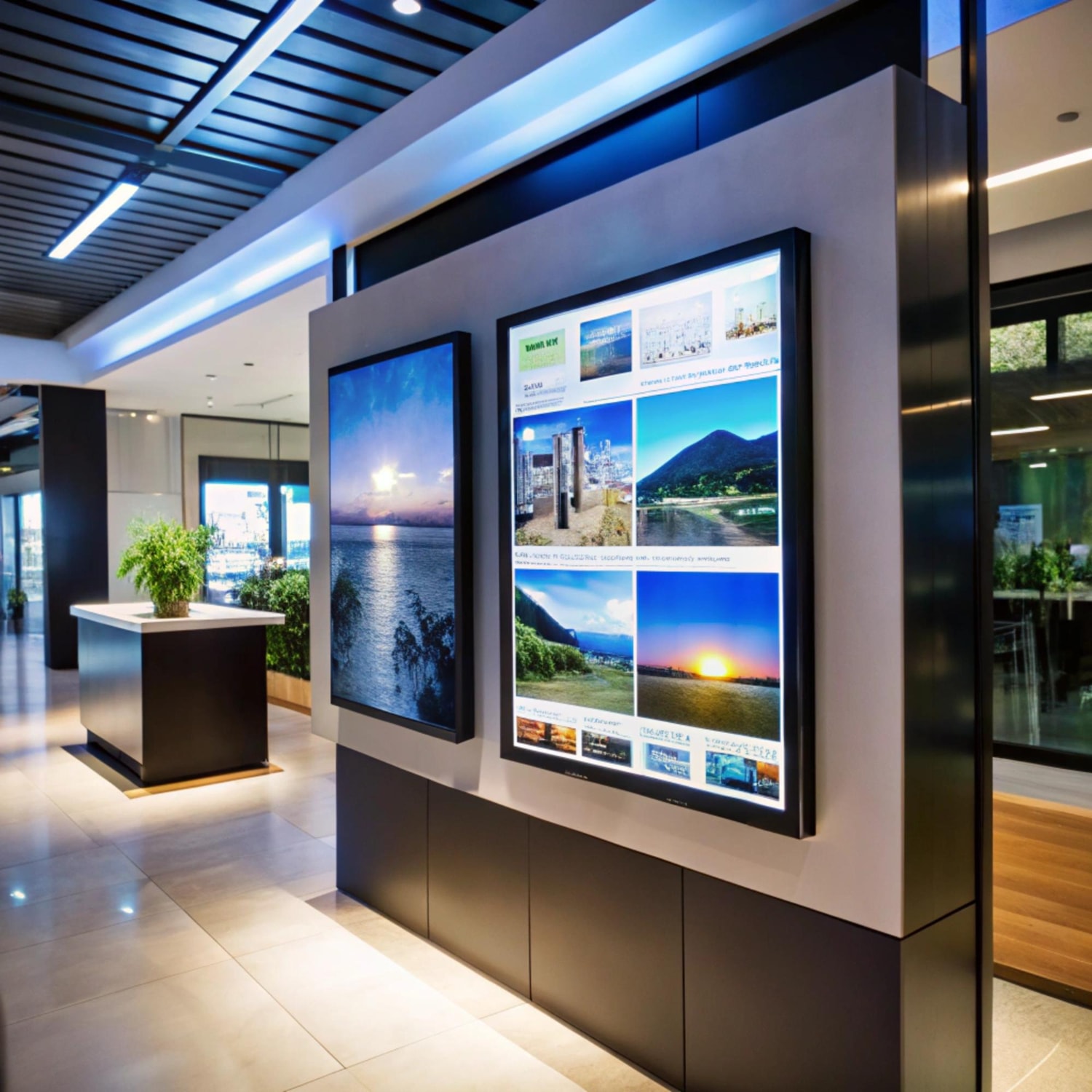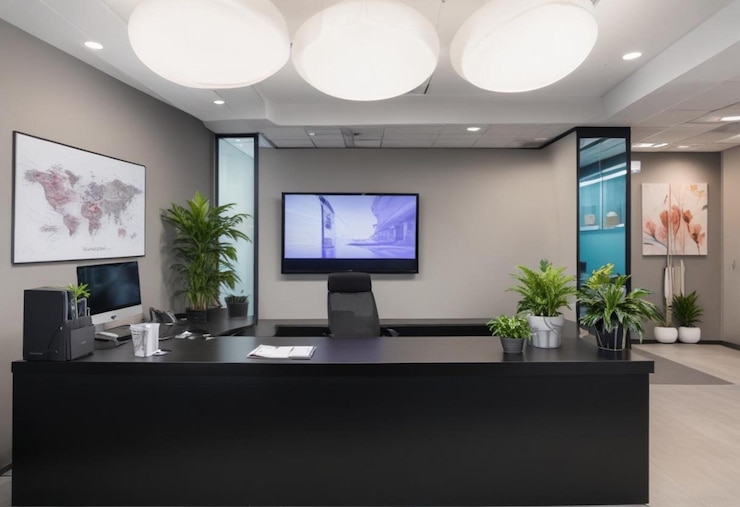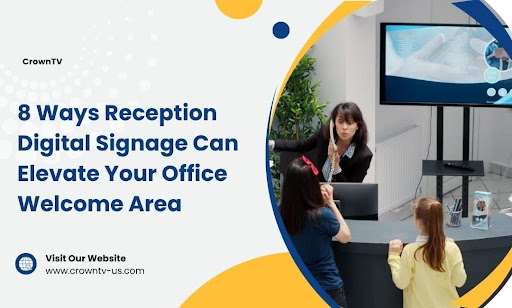The front desk doesn’t set the tone. Your screens do. People walk in expecting more than a smile and a clipboard. They scan the room before they speak. They notice what’s playing on the wall, not what’s in the brochure rack. A paper sign-in sheet won’t hold their attention, but dynamic digital signage will.
Here’s the problem: Most reception areas still feel stuck in 2011. Static branding. Cluttered counters. Forgettable welcomes. And that’s a missed opportunity, because your reception screen is the first real conversation your brand has with every person who walks in the door.
This article shows you how to pull that conversation forward and use digital signage to do something, not just decorate the space.
Here’s what we’ll cover:
- How to greet visitors automatically without making them wait
- Ways to showcase brand identity without repeating your logo
- How to cut down on front desk clutter without cutting service
- What to display to highlight staff, events, or announcements
- Tactics to entertain waiting guests and reduce perceived wait time
- How to guide foot traffic with screen-based cues
- Why signage makes corporate policies more visible and engaging
- And how to gather live data without being invasive
Every point is practical. Every fix makes an impact. By the end of this piece, you’ll know exactly what to put on your reception screen—and why it works.
1. Automate the Welcome Without Slowing People Down
Reception desks are busy for a reason. Phones ring. Packages come in. Deliveries need signatures. And the person walking through the door? They don’t want to stand around while staff multitask their way back to the front. That’s where screens step in.
When set up the right way, digital signage can handle the first five seconds of the guest experience—the moment when attention is highest and patience is lowest. Instead of waiting for someone to look up from their monitor, visitors are instantly greeted with a message that’s warm, visible, and responsive to the time of day or type of visitor.
What Works on a Welcome Screen
You don’t need to overcomplicate the message. But it should do something—acknowledge, orient, and reassure. For example:
- General greetings: “Welcome to [Company Name]” in large, legible type.
- Personalized content: Scheduled welcome messages for booked appointments or recurring visitors.
- Time-specific updates: Morning greetings that include the weather or lunch hour messages with cafeteria info.
- Wayfinding cues: Arrows, room numbers, or directions for where to go next.
Screens make the greeting feel active, even if no one is free to speak right away. And that matters more than it seems.
Why It Works?
The longer someone stands still, the more unsure they become. Automating a greeting helps move the interaction forward without depending on perfect timing. It tells the visitor they’ve been seen—even if they haven’t been helped yet. That small shift sets the tone for everything that follows.
It’s not about replacing your front desk staff. It’s about pulling the weight off them in small but smart ways.
2. Build Brand Memory Without Repeating the Logo
The logo isn’t your brand. It’s a symbol. A shorthand. Something people recognize, not something they feel.
Your brand identity comes through in tone, visuals, rhythm, and values, not the number of times a graphic shows up on screen. Reception digital signage gives you the space to express brand traits that go far beyond static marks.
Let the Brand Speak Through Motion and Content
Every frame on a welcome screen is a branding opportunity. Not with repetition, but with recognition—the kind that builds trust without trying too hard.
Use digital signage to:
- Reinforce brand colors through motion backgrounds and layouts
- Share short-form company videos that introduce your team, mission, or story
- Highlight core values or community work with real photos or employee features
- Display branded templates with clean hierarchy, spacing, and fonts
- Show seasonal campaigns, milestones, or event footage that speaks to culture
The goal isn’t to fill the screen with marketing—it’s to create alignment. Every visual and every phrase should pull the message in the same direction.
Design With Purpose, Not Redundancy
Too many screens default to the same logo loop. It’s forgettable. People tune it out.
Instead, focus on cohesion—how the screen feels in context with your brand space. Does the tone of the copy match the way your team talks? Do the visuals reinforce the way your office looks and operates? These are the cues people remember.
A strong welcome screen doesn’t need to shout. It needs to fit the room, match the moment, and speak your brand fluently, without leaning on repetition.
3. Clear the Counter Without Losing the Function

Brochures. Sign-in sheets. Flyers. Visitor passes. Safety protocols. Most reception desks look like a paper-based command center—until the clutter starts working against the experience.
Digital signage absorbs high-traffic materials and takes them off the desk. Instead of stacking papers, you’re staging content on a screen that updates without needing to be refilled, wiped down, or reorganized.
Replace Paperwork With Screens That Do the Work
You can transfer more than announcements. A well-placed screen can take on:
- Visitor check-in instructions
- Building maps or meeting room details
- Wi-Fi login info
- Health or safety notices
- Temporary policy changes or alerts
This shift does two things: it frees up physical space and keeps information consistent. No reprinting. No lost flyers. No outdated copies floating around the counter. It also makes your front desk feel intentional, not improvised.
A cleaner desk isn’t about looks. It’s about showing visitors that your space is run with clarity. Screens help take over the communication load without sacrificing detail or access.
4. Put Faces, Events, and Updates Where People Look First
A wall-mounted flyer doesn’t draw attention. A front desk binder goes untouched. But the screen in your reception area? That’s where people naturally focus when they walk in. It’s visual real estate—the kind you can use to spotlight what matters most inside the building.
- Make Staff Recognition Public: Use reception screens to introduce new hires, spotlight achievements, or highlight internal promotions. Headshots. Names. Roles. A short quote or a win. Rotate the display weekly or monthly to keep it fresh and purposeful. It sends a message—this team matters, and people are paying attention.
- Promote Upcoming Events Without Sending a Memo: Whether you’re hosting a lunch-and-learn, participating in a fundraiser, or closing early for a holiday, signage can carry the update. No extra emails. No missed memos. One screen, always visible, always current. This approach gives visitors and employees the same access to relevant information without forcing them to go search for it.
- Keep Announcements Clear and On Rotation: Instead of pinning updates to a corkboard, queue them into a timed loop. This could include:
- Policy reminders
- Tech maintenance alerts
- Shout-outs or internal news
- Company-wide scheduling updates
Every announcement gets screen time. And because it’s digital, you control what shows, when it shows, and how long it stays up. That kind of visibility builds awareness without flooding inboxes or filling walls.
5. Keep Guests Occupied Without Adding Staff Work
Waiting rooms don’t need magazines anymore. They need motion. Visitors expect screens—clean, quiet, and engaging enough to keep them from checking the time every two minutes. Reception digital signage meets that expectation without adding new tasks to your front desk. The key is using the screen to hold attention and move it forward.
What to Put on Screen in 2025
Not all content entertains. Slideshows don’t hold attention. Static images fade into the background. But dynamic, relevant, and well-paced media can shift how people experience a wait.
Here’s what works:
- News tickers filtered to match the tone of your workplace
- Local weather updates paired with calming visuals
- Short branded videos with captions or animation
- Live social media feeds from verified company channels
- Event countdowns or milestone trackers
- Trivia loops or workplace fun facts
- Behind-the-scenes video snippets with team highlights
The goal isn’t to distract—it’s to occupy attention with content that feels like it belongs in your space.
Reduce Wait Friction Without Sacrificing Focus
Even a short wait can feel longer if there’s nothing to look at. Digital signage fills that void without overwhelming the room. With the right pacing and design, screens reduce perceived wait time without increasing cognitive load.
This creates a smoother experience. No one needs to ask how long they’ll be. The screen pulls time forward, quietly and effectively.
6. Direct Movement Without Verbal Instructions
People don’t always ask where to go. They look around. They scan walls. They guess. That’s where reception signage becomes more than a screen—it becomes a quiet guide. By placing screens in smart locations and feeding them with clear directional cues, you can cut down on confusion and avoid front desk interruptions.
Use Visual Cues to Shape Movement
Strategic screen content can:
- Point toward elevators, conference rooms, or waiting areas
- Highlight department names with arrows or icons
- Clarify check-in steps with motion graphics
- Label areas like restrooms, exits, or private zones
- Show floor plans or interactive maps during peak hours
Visitors get answers without needing to stop and ask.
Support Temporary Changes Without Reprinting Signs
During high-traffic days or internal events, printed signage can’t keep up. Screens let you:
- Display time-sensitive routes for large meetings or trainings
- Redirect traffic when areas are blocked off
- Guide vendors or deliveries to alternate entry points
- Rotate messaging based on time of day or staff schedules
Foot traffic management isn’t about controlling people. It’s about helping them move through the space without hesitation. Reception signage does this without adding more pressure to your team.
7. Turn Corporate Policies Into Clear On-Screen Content

Policies are only useful when people see and understand them. Reception signage turns passive printouts into active visual content that delivers the message without making guests hunt for it.
Most visitors don’t flip through handouts or stop to read the fine print posted in frames. But they’ll look at a screen. And that’s the opportunity to display critical information in a way that’s visible, brief, and easy to process.
What to Display in 2025?
Workplace policies have changed. They’ve become more fluid, often updated based on health trends, hybrid schedules, and new expectations around conduct and access. Reception screens offer a clean way to present:
- Visitor access protocols (e.g., no unaccompanied access past reception)
- Mask or hygiene policies, especially during seasonal surges
- Hybrid workday schedules (e.g., which departments are in-office)
- Security and ID badge requirements
- Quiet zone reminders for adjacent workspaces
- Code of conduct highlights for external visitors or vendors
- Device usage policies in shared or confidential spaces
These aren’t meant to overwhelm. They’re meant to orient fast.
How to Make the Message Stick?
Digital screens should break up long policies into quick, digestible frames. That means:
- Showing one core policy at a time
- Using icons or motion graphics to support key points
- Keeping each message under 15 words
- Rotating content every few seconds for better scanability
- Styling policies with brand fonts and tone for consistency
Reception signage can’t replace full documentation. But it can put the right pieces of those documents in front of the right people, right when it counts.
8. Use Live Data Without Overstepping Boundaries
Reception screens aren’t limited to static content—they can pull in live data feeds that keep the space current, relevant, and adaptive. But the way you source and display that data matters. The goal is to inform, not to expose. You want to share useful insights without showing anything personal, confidential, or traceable to specific individuals.
What Kind of Live Data Works in Reception
The right feeds add value to the visitor experience without triggering privacy concerns. Reception digital displays can rotate reliable, up-to-date information while keeping content professional and unobtrusive.
Here’s what you can safely display:
- Building occupancy levels to manage expectations during peak hours
- Estimated wait times pulled from scheduling systems
- Weather updates that change throughout the day
- Public transit arrival times for local routes
- Meeting room usage updates shown by availability status, not names
- Air quality or ventilation system status in shared areas
In corporate offices, this type of live screen content helps visitors feel more informed while giving your team fewer questions to answer manually.
Keep It General, Not Personal
To avoid privacy missteps, skip feeds that include:
- Names of visitors or staff
- Personal appointment details
- Footage or facial recognition overlays
- Location tracking tied to individuals
Instead, work with anonymized data or public content. Use your TV screen to display trends, not traces—especially when positioned near waiting zones or main check-in areas.
Pairing live updates with subtle promotional videos or occasional signage ideas (like employee shout-outs or upcoming events) can also increase screen engagement without adding clutter. For offices that use digital menu boards, this same approach can translate to service areas or internal cafés.
Whether you’re managing a single reception point or layering office signage throughout the building, the same rule applies: Keep content helpful, not personal. It’s the fastest way to build trust while keeping communication sharp.
The Most Practical Way to Bring Reception Signage to Life
Knowing what to display is only half the work. The real results come from putting the right signage system in place—one that runs smoothly, looks sharp, and stays flexible as your needs shift.
CrownTV makes that possible.
If you’re in NYC—or anywhere in the U.S.—CrownTV offers a full-stack software solution built specifically for modern office spaces. From screen setup to content control, the platform handles the entire reception area signage experience without making your team jump through technical hoops.
A Dashboard That Gives You Full Control
Everything covered above—automated greetings, policy updates, internal news, guest-facing videos—can be managed directly from CrownTV’s cloud-based dashboard. You can:
- Schedule content in advance
- Push updates across multiple screens
- Customize layouts based on time of day or visitor flow
- Rotate announcements without touching the hardware
The control panel of this digital signage software keeps every screen current without adding extra work to your front desk. It’s especially useful in large office spaces where consistency matters.
A Media Player That Runs Without Fail
Reception screens don’t get second chances. They need to load fast, run clean, and stay on, regardless of how busy the office environment gets. That’s exactly what CrownTV’s digital signage player delivers. Once installed, the device handles everything your welcome area needs—quietly and consistently.
Use the media player to:
- Run scheduled greetings, visitor messages, and daily content loops
- Keep signage running during network slowdowns with built-in caching
- Boot automatically after outages without manual resets
- Power multiple lobby screens on a single unit
- Stay up to date with remote firmware and performance monitoring
It’s hardware that holds the line. No noise. No delay. Digital signs that show up on time, every time.
Apps That Turn One Screen Into a Versatile Display
You’re not stuck with a static slideshow. CrownTV’s app integrations let you pull in:
- Live traffic and weather
- Office calendars
- Internal social feeds
- Building directories
- Local alerts or system data
This allows you to surface company news, push out company-wide events, and keep visitors informed—all from one screen. You can even reinforce company culture by mixing in user-generated content or customer testimonials during key moments.
When needed, you can also use customizable templates to adapt signage for sales figures, event recaps, or dynamic content around interactive elements. It’s a flexible digital signage strategy that adapts to your messaging needs.
Installation That Covers the Details
You don’t need to manage cabling, mounting, or configuration yourself. CrownTV’s installation service takes care of screen placement, wiring, and setup. That includes:
- On-site walkthroughs
- Screen recommendations based on space layout
- Hardware delivery and setup
- Ongoing support if you need it later
It’s built to handle both single locations and existing systems spread across multiple sites.
From digital directories in your office lobby to engaging content on commercial-grade screens, CrownTV helps you align signage with real goals, not with traditional signage headaches. If your lobby digital signage needs to do more than play nice visuals, this is the system to get it done.
Make Reception Signage Work Smarter With the Right Setup
The difference between a generic lobby and a memorable welcome area comes down to what the screen actually does. When you use reception signage with purpose—backed by the right software, hardware, and digital signage content strategy—you don’t just upgrade the look. You improve how people move, wait, ask, respond, and connect the moment they walk through the door.
What starts as a visual upgrade becomes an operational win:
- Visitors move through the space with less friction
- Front desk staff get fewer repetitive questions
- Internal updates become more visible without extra messaging
- Policies stay current and accessible without printing a thing
- Brand identity shows up through action, not repetition
- Wait time feels shorter, and more productive
It’s not about adding more digital signage screens. It’s about putting the ones you already have to better use. CrownTV brings together the software, players, apps, and installation support to turn your reception area into something that works, not just looks good. If you’re ready to stop patching things together and start running your welcome area with purpose, this is how you do it.

